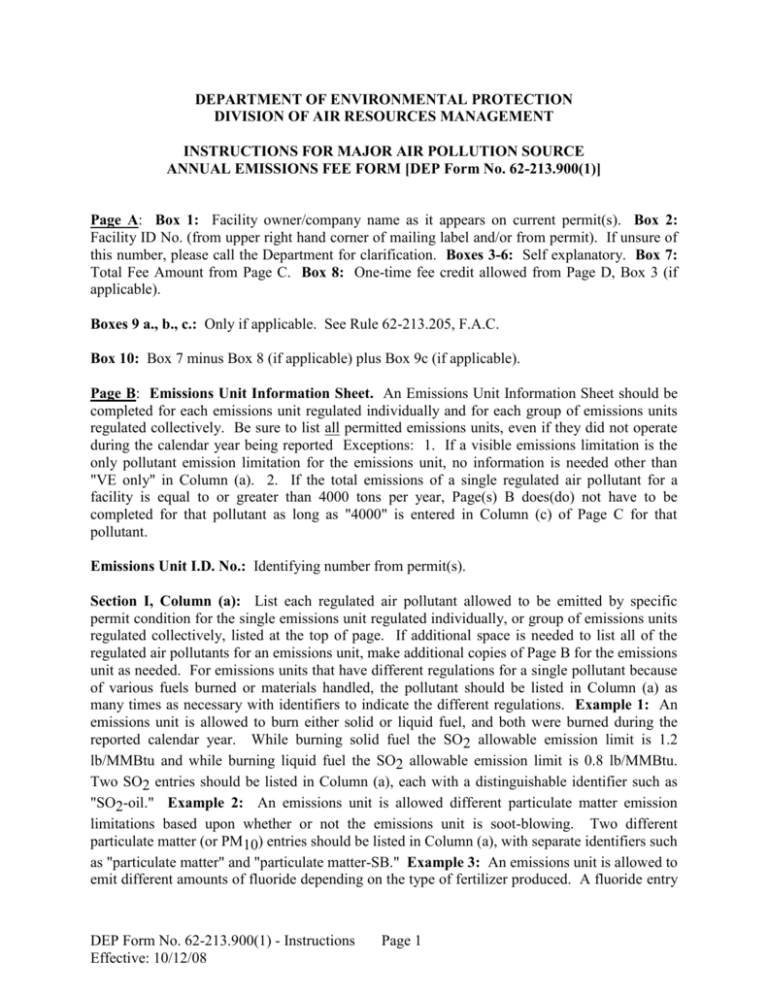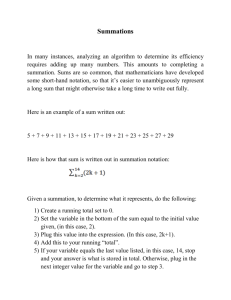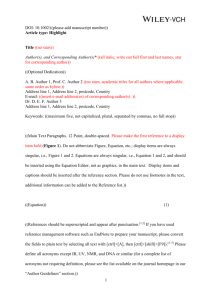DEPARTMENT OF ENVIRONMENTAL PROTECTION
advertisement

DEPARTMENT OF ENVIRONMENTAL PROTECTION DIVISION OF AIR RESOURCES MANAGEMENT INSTRUCTIONS FOR MAJOR AIR POLLUTION SOURCE ANNUAL EMISSIONS FEE FORM [DEP Form No. 62-213.900(1)] Page A: Box 1: Facility owner/company name as it appears on current permit(s). Box 2: Facility ID No. (from upper right hand corner of mailing label and/or from permit). If unsure of this number, please call the Department for clarification. Boxes 3-6: Self explanatory. Box 7: Total Fee Amount from Page C. Box 8: One-time fee credit allowed from Page D, Box 3 (if applicable). Boxes 9 a., b., c.: Only if applicable. See Rule 62-213.205, F.A.C. Box 10: Box 7 minus Box 8 (if applicable) plus Box 9c (if applicable). Page B: Emissions Unit Information Sheet. An Emissions Unit Information Sheet should be completed for each emissions unit regulated individually and for each group of emissions units regulated collectively. Be sure to list all permitted emissions units, even if they did not operate during the calendar year being reported Exceptions: 1. If a visible emissions limitation is the only pollutant emission limitation for the emissions unit, no information is needed other than "VE only" in Column (a). 2. If the total emissions of a single regulated air pollutant for a facility is equal to or greater than 4000 tons per year, Page(s) B does(do) not have to be completed for that pollutant as long as "4000" is entered in Column (c) of Page C for that pollutant. Emissions Unit I.D. No.: Identifying number from permit(s). Section I, Column (a): List each regulated air pollutant allowed to be emitted by specific permit condition for the single emissions unit regulated individually, or group of emissions units regulated collectively, listed at the top of page. If additional space is needed to list all of the regulated air pollutants for an emissions unit, make additional copies of Page B for the emissions unit as needed. For emissions units that have different regulations for a single pollutant because of various fuels burned or materials handled, the pollutant should be listed in Column (a) as many times as necessary with identifiers to indicate the different regulations. Example 1: An emissions unit is allowed to burn either solid or liquid fuel, and both were burned during the reported calendar year. While burning solid fuel the SO2 allowable emission limit is 1.2 lb/MMBtu and while burning liquid fuel the SO2 allowable emission limit is 0.8 lb/MMBtu. Two SO2 entries should be listed in Column (a), each with a distinguishable identifier such as "SO2-oil." Example 2: An emissions unit is allowed different particulate matter emission limitations based upon whether or not the emissions unit is soot-blowing. Two different particulate matter (or PM10) entries should be listed in Column (a), with separate identifiers such as "particulate matter" and "particulate matter-SB." Example 3: An emissions unit is allowed to emit different amounts of fluoride depending on the type of fertilizer produced. A fluoride entry DEP Form No. 62-213.900(1) - Instructions Effective: 10/12/08 Page 1 should be made in Column (a) for each type of emission limitation such as "fluoride-GTSP" and "fluoride-DAP." Section II, Columns (b), (c), (d), and (e). For each pollutant listed in Column (a), list the most limiting maximum allowable pollutant emission rate specified in the permit. Though a pollutant may be limited by each of the three different condition types listed, only one, the most restrictive for the year, of the Columns (b), (c), or (d) should be filled in. Example 1: "pounds per hour" is the most limiting maximum emission rate. Enter this limitation in Column (b). In most cases, if the Column (c) "tons per year" is specified in a permit as a limiting condition it will simply be Column (b) "pounds per hour" multiplied by Column (f) "maximum allowed annual hours of operation" divided by 2000 (pounds per ton). If this is the case, because "tons per year" would just be another version of "pounds per hour," it is not necessary to enter "tons per year" in Column (c), just enter the "pounds per hour" in Column (b). Example 2: Sometimes the maximum allowable hours per year is not stated in the permit and a "tons per year" limitation is specified which is more restrictive than the Column (b) "pounds per hour" multiplied by 8760 (default number of hours per year). In this case, the "tons per year" should be entered in Column (c) as this is the most limiting rate. Also, due to production variations, or perhaps to avoid more stringent regulations, an emission unit is sometimes given a more limiting "tons per year" emission rate that has no direct correlation with the "pounds per hour" limitation given, or perhaps there is no "pounds per hour" limitation at all. The "tons per year" should be entered in Column (c). Example 3: The most limiting maximum allowable pollutant emission rate is based on tons of pollutant emitted per unit of material input, heat input or product output, rather than "pounds per hour" or "tons per year." For an emission limit such as 0.0015 tons of VOC allowed per gallon of coating, list tons (0.0015) in Column (d) and list the material input unit (gallon) in Column (e). For an emission limit such as 0.0004 tons of SO 2 allowed per MMBtu heat input, list tons (0.0004) in Column (d) and list the heat input unit (MMBtu) in Column (e). Example 4: If the sulfur dioxide limitation for the emissions unit is specified in terms of a %S fuel limit, convert the %S to tons of SO2. SO2, not S, should be listed as the regulated air pollutant in Column (a). For a boiler firing No. 6 fuel oil with a %S limit of 2.5% by weight, multiply the annual fuel oil consumption allowed by permit (or actual fuel oil consumption if documented) times the density of the fuel oil times the maximum percent sulfur limit times the stoichiometric conversion factor of 2 (2 pounds of SO2 formed per pound of sulfur burned). [1,000,000 gal/year x 8.33 lbs/gal (x 1/2000 tons per pound) x 0.025 x 2 = 208 tons SO 2/year.] If the fuel limit is based upon BTU input rather than gallons of fuel, the allowable BTU input must be divided by the (BTU/gal) heating value of the fuel oil to obtain gallons. Section III. Maximum Annual Operating Conditions as Allowed by Permit Condition. Column (f): For each pollutant listed in Column (a), list the corresponding maximum annual hours of operation allowed at the maximum allowable pollutant emission rate for the emission unit by permit condition. Example 1: An emission unit is allowed to operate 8 hours/day, 5 days/week, 52 weeks/year. The maximum annual hours to be entered in Column (f) is 2080 (8 x 5 x 52). Example 2: For a boiler with a particulate matter limitation for normal operation and a particulate matter limitation for soot-blowing (SB) with the SB limited to 3 hours per 24-hour period and the boiler is allowed to operate 8760 hours per year, the maximum allowable annual hours of operation for pollutant "particulate matter-SB" should be listed as 1095 (3 hours times DEP Form No. 62-213.900(1) - Instructions Effective: 10/12/08 Page 2 365 days/year); and, for pollutant "particulate matter," the maximum annual hours of operation should be listed as 7665 (8760 hours/year minus 1095). Column (g): For each pollutant listed in Column (a) that has as its most limiting maximum allowable emission rate a value listed in Column (d), enter the maximum annual amount of material input, heat input, or product output allowed by permit condition. The amount must be expressed in the same units as listed in Column (e). Example: If a boiler has as its maximum permitted heat input rate 4000 MMBtu/hour, and as its maximum permitted hours of operation 8760 hours per year, the maximum allowable annual heat input to be entered in Column (g) is 35,040,000 (4000 x 8760). The units are understood to be MMBtu if these are the units that were entered in Column (e). Section IV. Actual Annual Operating Conditions as Documented For The Reported Calendar Year. For the operating conditions to be considered "documented," the records (e.g., operation logs, fuel receipts, inventory records, etc.) which were used to determine the operating conditions must be kept on file at the facility and available for review by Department personnel. Column (h): For each pollutant listed in Column (a) having documented actual annual operating hours for the emissions unit, list the actual annual hours of operation. Column (i): For each pollutant listed in Column (a) that has as its most limiting maximum allowable emission rate a value listed in Column (d), enter the actual annual amount of material input, heat input, or product output if the actual amount is documented. The amount must be expressed in the same units as listed in Column (e). Section V. Annual Emissions to Which Fees Apply. Column (j): [If the emissions unit's actual emissions of the pollutant were recorded by means of a continuous emissions monitor (C.E.M.) or other method approved by the Department for this purpose, skip this Column and enter the actual recorded emissions in Column (k).] The calculated annual tons of pollutant emissions are determined by multiplying the most limiting maximum allowable pollutant emission rate specified in Section II times the corresponding operating condition in Section III (or Section IV if the operating conditions are documented). All documentation of actual conditions must be retained for at least 5 years. Example 1: An emissions unit is allowed to emit 30 pounds per hour of particulate matter. The annual hours of operation were not documented, but the permitted hours of operation are 8760. To calculate annual tons of particulate matter, multiply 30 [from Column (b)] times 8760 [from Column (f)]. This results in calculated particulate matter emissions of 262,800 pounds per year. However, because the reporting units for Column (j) are "tons," divide 262,800 pounds/year by 2000 (pounds per ton) to determine the tons emitted per year to be entered in Column (j). Example 2: An emissions unit is allowed to emit 30 pounds per hour of particulate matter. The annual hours were documented to be 2080. To calculate annual tons of particulate matter, multiply 30 [from Column (b)] times 2080 [from Column (h)]. This results in calculated particulate matter emissions of 62,400 pounds per year. However, because the reporting units for Column (j) are "tons" divide 62,400 pounds/year by 2000 (pounds per ton) to determine the tons emitted per year to be entered in Column (j). Example 3: An emissions unit is allowed to emit 3 pounds of NOx per ton of nitric acid produced. The annual tons of nitric acid produced were documented to be 100,000. To calculate annual tons of NOx, multiply 0.0015 [3 pounds (converted to tons) from Column (d)] times 100,000 tons of acid per year [from Column (i)]. This results in calculated NOx emissions of 150 tons per year to be entered in Column (j). If the DEP Form No. 62-213.900(1) - Instructions Effective: 10/12/08 Page 3 acid production was not documented for the year, and the allowed annual production by permit condition is 120,000 tons of acid per year, the annual emissions of NOx would be calculated by multiplying 0.0015 [from Column (d)] times 120,000 [from Column (g)]. This results in calculated NOx emissions of 180 tons per year to be entered in Column (j). Example 4: The most limiting maximum allowable pollutant emission rate for an emissions unit of SO 2 is 240 tons per year [as entered in Column (c)]. This is considered the calculated allowable annual tons of SO2 and is entered in Column (j). Column (k): If an emissions unit's actual emissions of the pollutant were recorded by means of a C.E.M. or other method approved by the Department for this purpose, enter the actual recorded emissions in Column (k). The method code must be entered in Column (l). Column (l): Code for method by which actual emissions listed in Column (k) were recorded. Code a b c Method DEP-approved continuous emissions monitor Emissions monitoring method approved by the USEPA as specified in 40 CFR Part 75, Acid Rain Method approved by the DEP Bureau of Air Regulation for this purpose, i.e. VOC inventory balance. Page C: Fee Payment Calculation Sheet. Complete as indicated on form. Total Fee Amount must be no less than the $250.00 minimum fee. Page D: One-Time Fee Credit Calculation Sheet. Any emissions unit, or group of emissions units, which does not emit any regulated air pollutant in excess of 4000 tons per year, is allowed a one-time credit, not to exceed 25 percent of the first annual emissions fee, for the prorated portion of existing air operation permit application fees remaining upon commencement of the annual emissions fees. This is a one-time credit for state fees only. The one-time credit does not apply to the $250 minimum fee. Column (c): Full years remaining in the life of the permit. Example 1: Permit expires 6/10/99. Calendar year 1995 emissions reported 3/1/96. "Full years remaining" equals 6/10/99 - 3/1/96 = 3. Example 2: Permit expires 2/15/99. Calendar year 1995 emissions reported 3/1/96. "Full years remaining" equals 2/15/99 - 3/1/96 = 2. Column (d): Permit term length (to nearest amount of full years) can be determined by comparing the permit issuance date to the permit expiration date. In most cases this is 5 years, but there are some exceptions. Column (e): The credit factor is determined by dividing the "Full years remaining" listed in Column (c) by the "Permit term length" listed in Column (d). Column (f): Enter the state permit application processing fee amount that was paid at the time the permit was applied for. Column (g): The credit amount is determined by multiply the "credit factor" listed in Column (e) times the "state permit application processing fee paid" listed in Column (f). Box 1: Total of the credit amounts listed in Column (g). Box 2: Multiply 0.25 (25%) times the "Total Fee Amount" listed on Page C of form and enter amount in Box 2. Box 3: Enter the total credit amount allowed, which is the lesser amount of Boxes 1 and 2. DEP Form No. 62-213.900(1) - Instructions Effective: 10/12/08 Page 4







